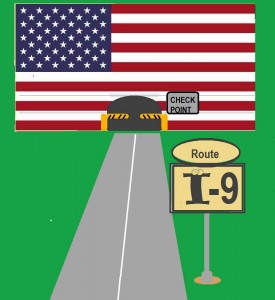Filing an I-9: a Recruiter or Company Responsibility?

ROUTE I-9/Image: Michael Moffa
Before even looking at the musts and cans, the dos and don’ts, or the whos, whats, hows and whens of filing a Form I-9, the U.S. government’s employment eligibility form, it is important to know whether completing it is your responsibility as a recruiter, the responsibility of the company hiring the candidate, or a responsibility you both share.
The Authoritative DOJ Handbook for Employers
You probably think that filing the I-9 is not your responsibility at all, that, instead, it is the responsibility of your company or of the client company. After all, item 36 in the U.S. Department of Justice Handbook for Employers FAQ says that, with only limited exceptions, you don’t have to: “36. Q. If I am a recruiter or referrer for a fee, do I have to fill out I-9s on persons whom I recruit or refer?
A. No, with three exceptions. Agricultural associations, agricultural employers, and farm labor contractors are still required to complete I-9s on all individuals who are recruited or referred for a fee. However, all recruiters and referrers for a fee must still complete I-9s for their own employees hired after November 6, 1986. Also, all recruiters and referrers for a fee are still liable for knowingly recruiting or referring for a fee aliens not authorized to work in the United States.”
This limitation to agricultural recruiters is reinforced in the same handbook: Like the DHS Form I-9 PDF, the U.S. Department of Justice Handbook for Employers says, of the agricultural recruiters described above, “This limited class of recruiters and referrers for a fee must complete the Form I-9 when a person they refer is hired.”—which suggests that only those in this sub-category of recruiters are “employers” and must file an I-9 themselves. (Italics mine.)
The Authoritative DHS I-9 PDF
Ah, were it this simple! Unfortunately, in the Department of Homeland Security U.S. Citizenship and Immigration Services PDF, “Form I-9, Employee Eligibility Verification, OMB 1615-0047”, “employer” is defined as “all employers including those recruiters and referrers for a fee who are agricultural associations, agricultural employers, or farm laborer contractors.” The first problem with this definition is that it uses the word “employer” to define “employer”—a circular definition. So, unless you already know whether you, the recruiter, are considered by the DHS to be an employer, the definition presented in this DHS document won’t settle the question. (Italics mine.)
A second problem is that in its attempt to provide some specificity and clarity, this DHS offers a definition that includes, but does not limit recruiters to those in agriculture. So, a careful reading of this leaves open the possibility that all recruiters, as well as (or instead of?) the recruiters’ employers or client companies, in general are considered employers. On the other hand it does not clinch it. Read the DHS definition again: It says “including”, but omits “limited to”.
Ok. So back to the Handbook for Employers. If you revert to the DOJ Handbook for Employers, to find a clearer definition of “employer”, you won’t find one, because nowhere in the official document I reviewed could I find a definition of the term. So, juggling the two documents—the DOJ and the DHS overviews, you will find neither a clear definition of “employer” nor a conclusive determination as to whether non-agricultural recruiters are to be considered employers.
The Authoritative DHS Glossary
But don’t give up just yet. A more detailed definition is provided in the glossary at the DHS Department of Citizenship and Immigration website: “Employer— A person or entity, including an agent or anyone acting directly or indirectly in the interest thereof, who engages the services or labor of an employee for wages or other remuneration to perform work in the United States. The term employer includesagricultural recruiters and/or referrers for a fee. In the case of an independent contractor or contract labor or services, the term employer means the independent contractor or contractor and not the person or entity using the contract labor.” (Italics mine, for the reasons above and reasons below.) This definition suggests that every “agent or anyone directly or indirectly in the interest thereof…” is an employer. This includesyou, irrespective of whether you are an agriculturalrecruiter.
Moreover, this DHS Glossary definition, like that of the DHS I-9 PDF, is also somewhat circular, to the extent that “thereof” designates “employer”. This presents you with two problems: First, once again, you still don’t know what “employer” means, apart from “employer” and “agents thereof”. Second, like the DHS I-9 PDF, this glossary definition ipso facto suggests you are the employer, since you are indeed an “agent thereof”.
But wait! You may still be off the hook when it comes time to file the I-9: The glossary comes with a caveat and disclaimer about the limits of this definition’s authoritativeness: “The terms described in it do not replace statutory, regulatory, or other definitions provided by law or Department of Homeland Security’s official policies and interpretations of law.” (Again, italics are mine, to highlight the point that the less clear and comprehensive definition of “employer” in the DHS Form I-9 PDF may supervene this one in any administrative or legal interpretation. Whether the FAQ limitation of responsibility for filing to agricultural recruiters also trumps the DHS Glossary definition is, alas, moot, since it does not state a definition of “employer”, instead merely exempting recruiters like yourself—if you are not an agricultural recruiter—from having to file I-9s.)
Clearing It Up
Confused? Well, the DOJ Handbook for Employers provides a complete listing of offices, state by state, that you can contact for clarification.
By U.S. Postal Service mail—and only by mail.
…which is at least one outstanding example of government agencies harmonizing, integrating and getting their acts together.

